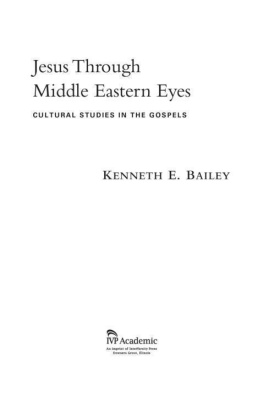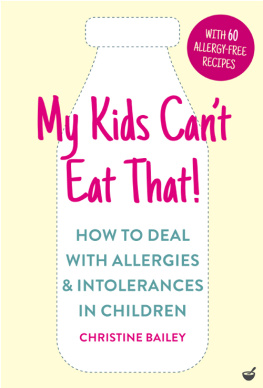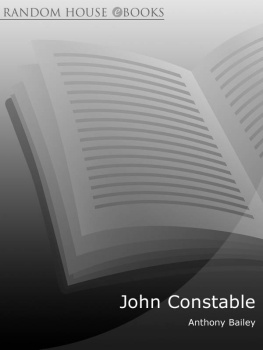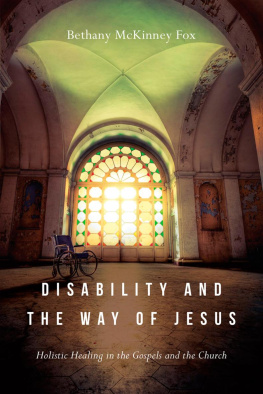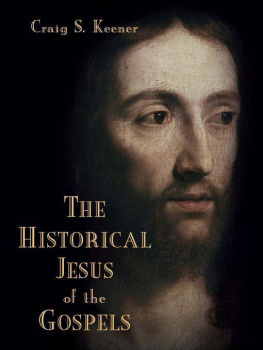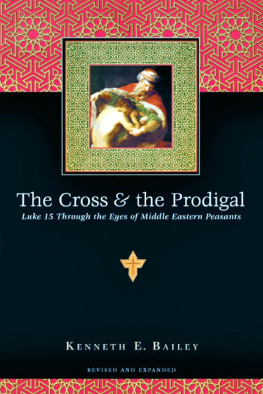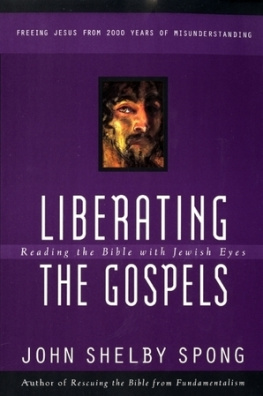Bailey - Jesus through Middle Eastern eyes : cultural studies in the Gospels
Here you can read online Bailey - Jesus through Middle Eastern eyes : cultural studies in the Gospels full text of the book (entire story) in english for free. Download pdf and epub, get meaning, cover and reviews about this ebook. City: Downers Grove, Ill, year: 2008, publisher: IVP Academic, genre: Religion. Description of the work, (preface) as well as reviews are available. Best literature library LitArk.com created for fans of good reading and offers a wide selection of genres:
Romance novel
Science fiction
Adventure
Detective
Science
History
Home and family
Prose
Art
Politics
Computer
Non-fiction
Religion
Business
Children
Humor
Choose a favorite category and find really read worthwhile books. Enjoy immersion in the world of imagination, feel the emotions of the characters or learn something new for yourself, make an fascinating discovery.
Jesus through Middle Eastern eyes : cultural studies in the Gospels: summary, description and annotation
We offer to read an annotation, description, summary or preface (depends on what the author of the book "Jesus through Middle Eastern eyes : cultural studies in the Gospels" wrote himself). If you haven't found the necessary information about the book — write in the comments, we will try to find it.
Jesus through Middle Eastern eyes : cultural studies in the Gospels — read online for free the complete book (whole text) full work
Below is the text of the book, divided by pages. System saving the place of the last page read, allows you to conveniently read the book "Jesus through Middle Eastern eyes : cultural studies in the Gospels" online for free, without having to search again every time where you left off. Put a bookmark, and you can go to the page where you finished reading at any time.
Font size:
Interval:
Bookmark:

KENNETH E. BAILEY


DAVID MARK BAILEY
With Deep Gratitude for his Choice of Hope over Despair And for His Songs in the Night With Unfading Love
PART 1: THE BIRTH OF JESUS
PART 2: THE BEATITUDES
PART 3: THE LORD'S PRAYER
PART 4: DRAMATIC ACTIONS OF JESUS
PART 5: JESUS AND WOMEN
PART 6: PARABLES OF JESUS
THIS BOOK CAME ABOUT IN STAGES. Some of its chapters were originally transcriptions of professionally recorded video lectures. The meticulous work of transcription was done by my dear friend and colleague, Dr. Dale Bowne, professor of New Testament (emeritus), Grove City College. I am profoundly grateful to him for all his hard work both in transcribing and in commencing the process of transforming lecture-style material into readable prose.
Other chapters are composed of new material on studies of parables that I published nearly three decades ago. The majority of these chapters are presented here for the first time. I am deeply grateful to InterVarsity Press for the privilege of making these findings available to readers interested in examining texts in the light of traditional Middle Eastern culture.
The chapters are a selection. The birth of Jesus, Beatitudes, prayer, women in the ministry of Jesus, dramatic actions and parables are included. The goal is to offer brief glimpses of some of the treasures that await us as Western isolation from Middle Eastern Christian interpretation of the Bible is slowly brought to an end. My purpose is to add new perspectives to our understanding of the text, rather than to rearrange old ones.
I am grateful also to Joel Scandrett, my editor and friend, who has patiently guided this project from beginning to end. Always helpful and insightful, he has wisely urged me to strengthen the work in places of weakness and to clarify the text in places of obscurity. To him I am profoundly indebted.
My debt to my personal copy editor, Sara Bailey Makari, can never be paid. She has broken up my convoluted sentences, straightened my shifting tenses, identified many points of confusion and eliminated excess verbiage. In short, she has contributed enormously to whatever quality the final product may exhibit. Thank you, Sara.
For more than two decades I have had the rare privilege of the sound advice and wise council of an "advisory committee" comprising members of the Presbytery of Shenango (PCUSA) and more recently of the Episcopal Diocese of Pittsburgh. This highly qualified group of people now includes the Rev. Dr. William Crooks; Rev. Dr. David Dawson; Rev. Dr. Joseph Hopkins; Mr. Thomas Mansell, Attorney at Law; Rev. Pamela Malony; Mr. William McKnight, CPA; and Rev. Dr. Ann Paton. To all these dear friends I wish to express my long-term gratitude and indebtedness.
Many churches and individuals, known and anonymous, have helped support my continuing research efforts. Without their assistance I would not have been able to acquire the resources or complete the work of writing this book. I think particularly of the Eastminster Presbyterian Church, Wichita, Kansas, and Trinity Presbyterian Church, Mercer, Pennsylvania. To all of them I offer my sincere thanks.
Arabic-speaking Christian theologians and exegetes from roughly A.D. 900 to 1400 produced five centuries of the highest quality Christian scholarship, quality that is also found in the present.
For forty years it was the greatest privilege of my life to have been accepted, encouraged, loved, sustained, taught and directed by the living inheritors of that Semitic Christian world. For the good days and the hard days, together through wars and rumors of wars, I would thank them all. This book is but a flawed attempt to learn from their (and our) heritage and through it to try to think more clearly about the life and message of Jesus of Nazareth.
Soli Deo Gloria!
Kenneth E. Bailey
FOR SIXTY YEARS, FROM 1935-1995, my home was in the Middle East. With a childhood in Egypt and forty years spent teaching New Testament in seminaries and institutes in Egypt, Lebanon, Jerusalem and Cyprus, my academic efforts have focused on trying to understand more adequately the stories of the Gospels in the light of Middle Eastern culture. This book is a part of that continuing endeavor.
The written sources for such a quest are ancient, medieval and modern. As regards ancient literature (Aramaic, Hebrew, Syriac and Arabic), I am not solely interested in the Old Testament, the intertestamental literature, and the Dead Sea Scrolls. The post-New Testament Jewish literature (Mishnah, Midrash Rabbah and the two Talmuds) is also important. In addition to Judaica, there is the literature of the Eastern Semitic-speaking churches.
Writing about the importance of the Eastern Christian tradition, John Meyendorff says:
Middle Eastern Christians have been called the forgotten faithful. The world knows that across the centuries there have been Jews and Muslims in the Middle East. For the most part, however, Middle Eastern Christians evaporated from Western consciousness after the Council of Chalcedon in A.D. 451. Few are aware of the existence today of more than ten million Arabic-speaking Christians who possess a rich heritage of ancient and modern literature. Speaking a Semitic language, these Christians are a people who live, breathe, think, act and participate in Middle Eastern culture; they are rooted in the traditional ways of the Middle East. Their voices, past and present, need to be heard in biblical studies.
All of these sources, Syriac, Hebrew/Aramaic and Arabic, share the broader culture of the ancient Middle East, and all of them are ethnically closer to the Semitic world ofJesus than the Greek and Latin cultures of the West.
Out of that earliest period emerged the writings of Ephrem the Syrian and the three classical translations of the Gospel into Syriac: the Old Syriac, the Peshitta and the Harclean, all three of which have been consulted for this book.
His work on the Gospels is quoted repeatedly in this book.
A second major voice from the medieval period is the Coptic scholar Hibat Diyunisiyus Ja'qub ibn al-Salibi's (d. A.D. 1171) commentaries on the Gospels have also been consulted.
Font size:
Interval:
Bookmark:
Similar books «Jesus through Middle Eastern eyes : cultural studies in the Gospels»
Look at similar books to Jesus through Middle Eastern eyes : cultural studies in the Gospels. We have selected literature similar in name and meaning in the hope of providing readers with more options to find new, interesting, not yet read works.
Discussion, reviews of the book Jesus through Middle Eastern eyes : cultural studies in the Gospels and just readers' own opinions. Leave your comments, write what you think about the work, its meaning or the main characters. Specify what exactly you liked and what you didn't like, and why you think so.

